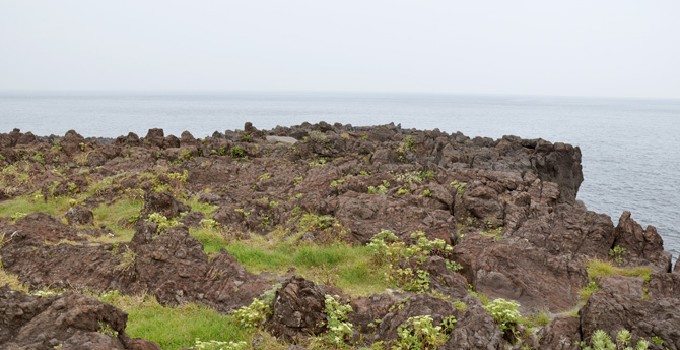Ōmuro Yama 大室山
(Mount Ōmuro)

Mt. Ōmuro: More Than a View
One of the most recognizable landmarks on the Izu Peninsula is Mount Ōmuro. For thousands of years, it has been an important figure in the lives of the people in nearby Ike, a small village at its southern base. Mt. Ōmuro has been getting a lot of social media attention recently.
I also live in Ike, and I’m glad to see the mountain that watches over my home and neighbors get such well-deserved attention.
That attention has brought bigger crowds. On busy weekends and holidays, the line for the chairlift (the only way to reach the top) can stretch past an hour. Most social media posts focus on the panoramic views on a clear day, which are amazing, but the mountain holds deep stories beneath its surface.

Forged in Fire
Mt. Ōmuro is a cinder or scoria-cone volcano formed by an eruption around 4,000 years ago. Its even, bowl-shaped form, about 300 meters across at the crater, rising to 580 meters above sea level, still captures attention.
That eruption reshaped the region. Lava flowed 4 kilometers into the valleys and toward the sea, forming the gently sloping Izu-Kōgen plateau and covering roughly nine kilometers of shoreline to create the rugged Jogasaki Coast. In places around Itō you can still see layers of pitch-black volcanic ash, a silent marker of the mountain’s explosive past.
Fire as Renewal
Every late winter, for more than 700 years now, the slopes are set alight in Yamayaki, literally “mountain burning.” Originally this cleared dead grass for thatched roofing and pest control. Today it’s still done partly for those reasons, but it’s also a striking festival that heralds spring. The fire ripples up the slopes in about 30 to 40 minutes, turning the mountain black before green returns in spring.

The Shrine at the Summit
At the center of the crater stands a small Sengen Shrine. Unlike most Sengen shrines, dedicated to Mt. Fuji’s goddess Konohanasakuya-hime, this one honors her older sister, Iwanagahime, the goddess of endurance and long life. For centuries, women have made a pilgrimage here to pray for safe childbirth and family well-being.
If you’d like to dive deeper into her story, I’ve covered it in detail in my post: Mt. Ōmuro’s Sengen Shrine.
Guardians of the Sea: Eight Jizō
As you begin a clockwise walk around the crater rim, one of the first things you come across is a row of eight Jizō statues facing the ocean. Jizō are protectors, especially of children and travelers . Fishermen placed these figures here to watch over them at sea.
What makes this row unusual is the number: eight 八つ地蔵. It’s far more common to see a single Jizō at a roadside or temple corner, or a set of six together. The larger number here suggests that this spot held special meaning for the fishing community, a place where the dangers of the open water felt close at hand.


Guardians of the Land: Five Nyorai
Continue further around the rim, and you’ll see another line of statues on the western side of the rim: five stone Nyorai. In Buddhist tradition, Nyorai are Buddhas who have reached full enlightenment. They are different from Bodhisattvas, who remain active in the world to guide others along the path.
The five Nyorai at Mt. Ōmuro were placed here more than 300 years ago. Lined up in a row, they face inland toward the mountains, a counterpoint to the Jizō looking out to sea. Together, the two groups link the mountain with both sides of local life: land and ocean, farming and fishing.
Reaching the Top
Because Mt. Ōmuro is a protected natural monument and its slopes are steep and fragile, there is no hiking path. A six-minute chairlift takes visitors to the summit. From there, it’s easy to circle the crater rim. Most people walk once around, take their photos, and descend. But if you pause at the shrine, stop in front of the statues, or better yet, join a local guide who can interpret the mountain’s stories and role in local culture, the visit becomes much more than a quick sightseeing stop.


A Place With Layers
Mt. Ōmuro isn’t just a landmark. It’s a place where geology, ritual, and everyday life meet: volcanic fire formed the land, ritual fire renews it each year, gods and Buddhas linger in the crater, and both farmers and fishermen turn to for protection. The views may draw people in—but it’s the layers of story, quiet and alive, that make the mountain worth discovering.
A Personal Note
When I guide people here, I encourage them to walk slowly, to notice more than the horizon. The shrine, the Jizō, the Nyorai, even the black volcanic soil underfoot—these details are what connect the mountain to the lives of people who have lived in its shadow for centuries. Many of those people are my neighbors who work at Mt. Ōmuro. For me, sharing these connections is what makes Mt. Ōmuro such a special place.

Mt. Ōmuro can be included in your full-day private tour. For guests staying in Izu-Kōgen with less time, we also offer half-day shared tours.
For more information about Mt. Ōmuro and the surrounding area, here are a few websites to visit:
https://english.izugeopark.org








